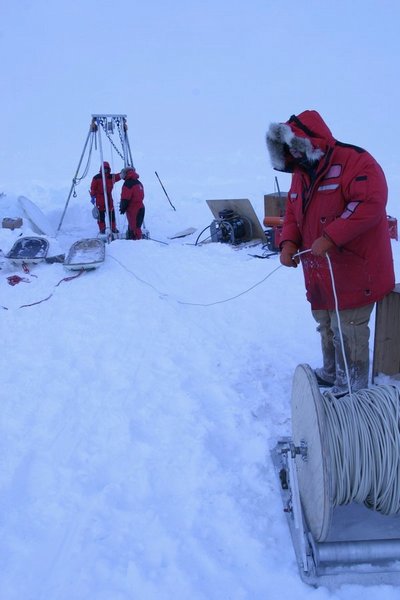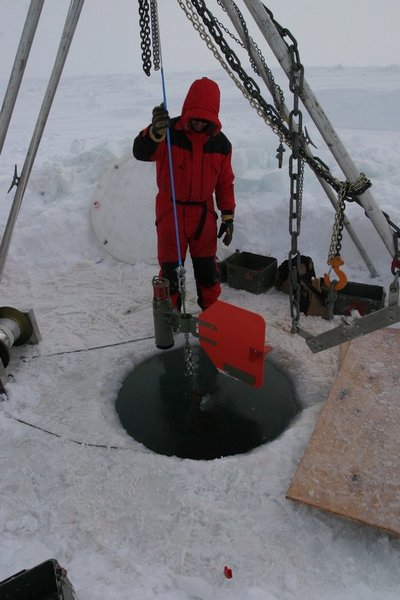May 8, 2006
Sixth expedition to North Pole installs mooring in 2 ½ miles of ocean
This year’s University of Washington-led North Pole Environmental Observatory program, which ran April 10 through early May, was followed immediately by another UW-led expedition concerning what’s called the freshwater switchyard of the Arctic Ocean, which is underway until about May 17.
The National Science Foundation-funded programs are monitoring changes in the Arctic where, last fall, the lowest amount of ice cover in more than a century was recorded, the fourth consecutive year of record and near-record lows.
Traveling to the ice this year for the projects were 23 scientists and engineers from eight U.S., Japanese and Norwegian institutions and one Canadian firm. About half the participants are from the UW’s Applied Physics Laboratory, including scientists, engineers, divers who go under the ice and logistics-support people.
With Applied Physics Laboratory’s oceanographer Jamie Morison as the science lead and engineer Andy Heiberg as the logistic lead, the North Pole Environmental Observatory program recovered a mooring with instruments that had been in 2 ½ miles of ocean near the North Pole. The instruments gather year-round information about layers of water that help determine how thick — or thin — the ice is in the Arctic. After the mooring that was out there for the past year was recovered, a new mooring was tethered to the seafloor. This is the sixth year in a row that a mooring was deployed.
Automated drifting stations were embedded into the surface of the ice in places. These are buoys that sit like plugs in the ice, often with instruments trailing on cables into the ocean below. Other instruments monitor the ice and atmosphere. The stations drift with the ice, sending data back to scientists via satellite.
A third element of the project involved surveys where researchers used airplanes or helicopters to fly across wide areas, landing in various places along the way to lower instruments into the ocean, take readings and bring the instruments back up.
Such surveying is the key activity of the Freshwater Switchyard program led by Applied Physics Laboratory oceanographer Mike Steele. The surveys are in a part of the Arctic Ocean between Canada’s Ellesmere Island and the North Pole that’s been found to reveal changes in the varieties of freshwater that the Arctic Ocean exports southward to the Atlantic Ocean. The area is like a train switchyard in that different “freshwater cargo” from various locations, such as major Russian and North American rivers, arrives there.
Changes in how fresh the water is in that region is of interest because it is salty, dense water in the North Atlantic Ocean that helps drive global ocean circulation.
###
For more information:
Morison, (206) 543-1394, morison@apl.washington.edu
— Reports from the field filed at: http://psc.apl.washington.edu/northpole/NP2006Reports.html
— Two live Webcam views from instruments at the North Pole at: http://psc.apl.washington.edu/northpole/
Institutions participating this year:
Applied Physics Laboratory
University of Washington
Bigelow Laboratory for Ocean Sciences
Boothbay Harbor, Maine
Japanese Marine Science and Technology Center (JAMSTEC)
Yokosuka City, Japan
NOAA’s Pacific Marine Environmental Laboratory (PMEL)
Seattle
Naval Postgraduate School (NPGS)
Monterey, Calif.
Oregon State University
Corvallis, Ore.
METOCEAN Data Systems
Dartmouth, Nova Scotia
METOCEAN designs and manufactures air-deployed and ship-deployed drifting buoys.
University of Bergen
Norway
Lamont-Doherty Earth Observatory
Columbia University, New York




